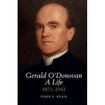
Remarkable news in Galway. After 50 years’ work, John Ryan, a former clerical employee of CIÉ, has published his life of Gerald O’Donovan (1871-1942). As early as 1975, Ryan was having his colleague Tadhg Foley look up O’Donovan-related connections around Oxford, where Foley was doing a doctorate in English.
In the late 1970s, the two friends, using a London telephone directory, discovered O’Donovan’s elderly daughter Brigid, once TS Eliot’s secretary at Faber. Coming gradually to trust Ryan, she handed over her father’s entire archive. Ryan then pursued leads through the archives of 20 research libraries, and ultimately made himself the complete master of his subject. He put it all down in this judicious, factual narrative of a fascinatingly original life.
Fr O’Donovan trained at Maynooth in the 1890s (when he was censured for reading modernist theology). He was assigned to Loughrea, where a new cathedral was being built. With a free hand to manage its decoration, O’Donovan was startlingly non-denominational in his selection of artists. He invited contributions from the Yeats sisters for banners, Sarah Purser for a stained-glass window and John Hughes for a statue of the Virgin. St Brendan’s Cathedral became the best example of an Irish Revival church.
[ Ahead of his time – Brian Maye on novelist Gerald O’DonovanOpens in new window ]
The rebelliously independent, patriot priest made common cause with other Protestant cultural nationalists, such as Douglas Hyde in the Gaelic League and Horace Plunkett in the co-operative movement. When Bishop O’Dea instructed him to stick to his parish duties, O’Donovan abandoned his ministry in 1904. Townspeople gathered on the platform and knelt for his blessing when his train left Loughrea, the last blessings he was to give as a priest. Like Joyce in the same year, the touchy idealist went into exile from family, church and country.
Netflix, Prime Video, Disney+, Apple TV+: 10 of the best new shows to watch in February
We built a bungalow on what was initially a boggy patch in my parents’ sloped front garden in Kerry
Des Bishop: ‘I never felt the grief with my dad like I felt with my mother’
LA after the fires: Like driving through a post-nuclear suburbia. The scale of destruction is unfathomable
George Moore used the story of a self-defrocking intellectual priest in his novel The Lake (1905). Urged by Moore to tell his own story in his own way, O’Donovan published Father Ralph in 1913. It depicts the church as the chief obstacle to the improvement of life in Ireland. Its realistic exposé of the lives of priests when among themselves outraged the hierarchy not just in Ireland but in Rome, a whistleblower classic. It may not be the best of O’Donovan’s six novels, but it is the best remembered. Waiting is about interdenominational couples unable to go forward with marriage because of the Ne Temere decree, and Vocations concerns women without a calling made to become nuns. He remained a venomous, intelligent and extremely well-informed critic of the church.
He had a brain well worth picking, perhaps one of the most uncorrupted minds ever to emerge from Maynooth seminary
In London, O’Donovan married the wealthy daughter of a British colonel from Fermanagh, Beryl Verschoyle. The couple had three children. Once settled in England, he spoke with an educated English accent (much better than that of TS Eliot, according to Brigid O’Donovan). During the war, he ran the Italian section of propaganda for the war office, while his friend HG Wells ran the German section. His secretary was the sparkling novelist Rose Macaulay; soon, the two fell in love. As a reader and (briefly) London manager of Collins Press, O’Donovan became the editor of Macaulay’s many books. The two became staples of the Bloomsbury circle, enviously despised by Virginia Woolf. Their secret relationship continued, alongside O’Donovan’s marriage, until his death in 1942. He is the key, unnamed force in her books.
In his last decades in London, George Moore continued to call on O’Donovan. He liked to pick the former priest’s brain. He had a brain well worth picking, perhaps one of the most uncorrupted minds ever to emerge from Maynooth seminary. Hurt, sardonic and idealistic, he always spoke with authority.
Henceforth, this will be the standard book on Gerald O’Donovan. No doubt, other studies will spill out of it – about Maynooth, Loughrea, modernist theology and the Irish priesthood, autobiographical fiction, the Irish revival, exiled post-Free State Irish writers in London, and English female novelists of the interwar period. That it was all achieved, unpaid, in the spare hours of a life working for CIÉ in Galway, is a thing of wonder.
The price is forbidding, but one may request a copy from one’s local library, and thus increase its circulation.














